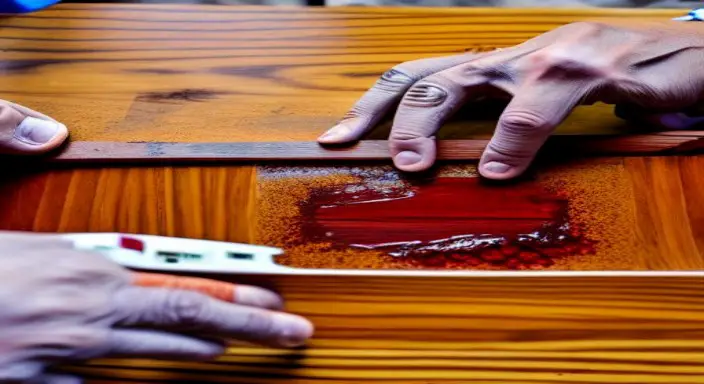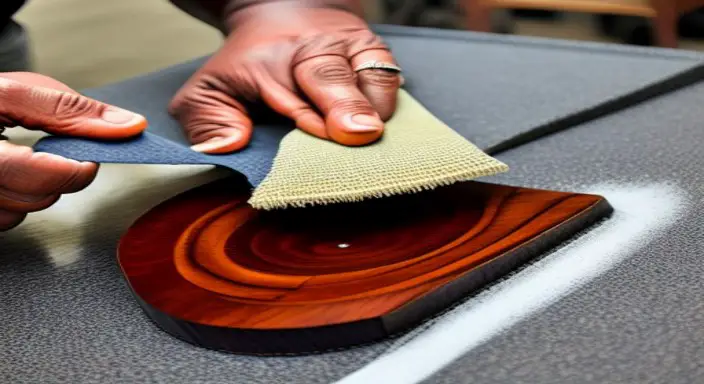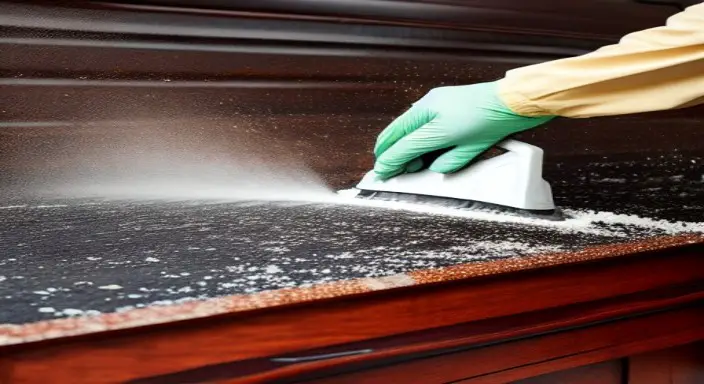Mahogany is a hardwood that is widely used in furniture and cabinetry manufacturing. Not only does it add elegance and sophistication to any space, but it is also known for its durability and strength. However, staining mahogany can be daunting, especially for beginners. From choosing the right type of stain to sanding and prepping the wood, many things must consider achieving a flawless finish. In this Home Affluence post, we will walk you through a step-by-step guide on how to stain mahogany like a pro. You will learn about the various stains available and the best application methods:
- Prepare the Mahogany surface.
- Apply the stain
- Apply a wood conditioner
- Sand the Mahogany
- Choose the right type of stain
- Apply a sealer
- Test the stain on a sample piece of wood
- Dry the stain
- Clean off the excess stain
- Finish the staining process
We will also discuss the importance of sanding and prepping mahogany before staining to achieve a smooth and even finish.
Additionally, we will touch on some tips and tricks to avoid common mistakes and ensure the final product matches your expectations.
How To Stain Mahogany
1. Prepare the Mahogany surface
The preparation of the mahogany surface is critical when staining mahogany wood. Before you begin the staining process, you must ensure the mahogany wood surface is clean and free of debris or dirt.
Start by sanding the mahogany wood with coarse-grit sandpaper, then medium-grit sandpaper, and finish with fine-grit sandpaper.

This process will remove dirt or debris and prepare the wood surface to accept the stain evenly. After sanding, wipe the wood surface with a clean cloth to remove any remaining sawdust or particles.
Ensuring the wood surface is completely dry before the staining process is essential.
Please adequately prepare the mahogany wood surface to avoid uneven staining or blotching, ruining the final appearance of the wood.
2. Apply the stain
Mahogany wood is known for its beautiful reddish-brown color that becomes richer and darker as the wood ages. One way to enhance this color is by applying a stain to the wood.
However, it is important to note that not all wood stains are created equal, and different wood types require different staining techniques.

The first step is to prepare the wood surface, which involves sanding the wood and cleaning it thoroughly. Once the wood is ready, you can move on to the second step of applying the stain.
This step involves choosing the correct type of stain and using the proper technique to ensure an even, consistent finish.
3. Apply a wood conditioner
If you want to enhance the natural beauty of mahogany wood, staining it could be the perfect way to do so. However, applying a wood conditioner to the wood is crucial before starting the staining process.
Mahogany is a dense wood that can be difficult to stain evenly due to its varying density. Applying a wood conditioner before staining will help even the wood surface, allowing for a more consistent stain application.

The conditioner penetrates the wood’s pores and fills any gaps or inconsistencies. It will level the wood’s surface and provide a smooth base for the stain to adhere to.
Adding a wood conditioner step to your staining process will help ensure a professional-looking finish that will last years.
4. Sand the Mahogany
To properly prepare mahogany for staining, it is necessary to sand the wood surface. Sanding removes any inconsistencies in the wood, including rough spots and minor blemishes. To begin, select 120-grit sandpaper and sand the entire surface in a circular motion.
Once complete, repeat the process with 220-grit sandpaper, focusing on smoothing out the wood fibers. Finally, use 320-grit sandpaper to create a smooth and even surface.

Ensure the wood is completely free of dust and debris after sanding, as any remaining particles may interfere with the final stain application.
Sanding the mahogany is a crucial step in the staining process. It creates a uniform surface that allows for even absorption of the stain, ultimately resulting in a beautiful and rich finish.
5. Choose the right type of stain
Choosing the right type of stain is a critical step in achieving a beautiful finish when staining mahogany. Mahogany is a dense hardwood that can be challenging to stain if you are not familiar with the wood’s properties and characteristics.
For optimal results, it is essential to select a stain that is specifically formulated for mahogany. Some popular stain types that work well with mahogany include oil-based and water-based stains.

Oil-based stains penetrate the wood’s pores, enhancing the grain’s natural beauty while providing a durable finish.
On the other hand, water-based stains offer an eco-friendly option and are easy to clean up with just soap and water.
No matter which stains you choose, test it on a small, inconspicuous area of the wood first to ensure that it achieves the desired color and finish.
6. Apply a sealer
Staining is a great option to breathe new life into the woodwork to impart a new look and feel to your mahogany floors, furniture, or other wooden items.
However, applying a good sealer after staining is important to ensure that your mahogany looks great and lasts for years.
This extra step acts as a protective layer on the wood’s surface, helping protect it from moisture, scratches, and other damage. To apply a sealer, ensure the stain has dried for at least 24 hours.
Then, using a clean brush or cloth, carefully apply the sealer in a thin, even coat over the surface of the woodwork.

Ensure that you cover every inch of the surface to prevent any areas from being left unprotected.
Once the sealer is applied, allow it to dry according to the product’s instructions. When choosing a sealer for your mahogany, opt for a clear sealer or one that closely matches the color of your stain.
The sealer will help bring out the mahogany’s rich colors and natural beauty while providing a protective barrier. With proper maintenance and regular re-application of the sealer, your mahogany
7. Test the stain on a sample piece of wood
One crucial step when staining mahogany is testing the stain on a sample piece of wood.
It will allow you to see how the stain looks on the wood and how many coats are needed to achieve the desired color.
Mahogany is a dense hardwood with a closed-grain structure, making it more difficult to stain evenly.

Testing the stain on a small, inconspicuous area will also help determine if pre-stain conditioning is needed to achieve a uniform color. Take a small mahogany and sand it to the same smoothness as the project piece.
Apply the stain to the test piece and let it dry completely. Evaluate the color and the number of coats.
If the color is not what you expected, try a different stain or modify the application method.
Once you have achieved the desired color on the test piece, you can confidently apply the stain to the project piece, knowing what to expect regarding color and coverage.
8. Dry the stain
Mahogany is a beautiful wood that can make any furniture or paneling look stunning.
When it comes to staining mahogany, there are certain steps that you need to follow to ensure a flawless finish. One of the essential steps in the staining process is drying the stain.

Here are the steps you need to follow to dry the stain while staining mahogany.
Step 1: Apply the Stain
Before you can dry the stain, you need to apply it to the wood.
Use a brush or cloth to apply a thin coat of stain to the wood in the direction of the grain.
Step 2: Let it Sit
Once you have applied the stain to the wood, let it sit for a few minutes. The amount of time you let it sit will depend on the recommended time on the stain’s label. Typically, it is about 10-15 minutes.
Step 3: Wipe Off the Excess
After the recommended sitting time has passed, use a clean cloth to remove any excess stain from the wood.
It will help prevent the wood from over-absorbing the stain.
Step 4: Let it Dry
Finally, let the wood dry before you start working on it again
9. Clean off the excess stain
Mahogany is a popular choice of wood for creating stunning furniture and decorative items.
For those who want to stain this beautiful wood, it is important to follow the proper steps to ensure an even and rich finish. One crucial step is to clean off any excess stain that may apply during the staining process.

It helps to prevent unevenness and blotchy finishes. Use a clean cloth, a crumpled-up paper towel, or a lint-free rag to clean off the excess stain.
Wipe off the excess stain gently, careful not to rub or smear it onto the surrounding areas.
Cleaning off excess stains will ensure a professional, flawless finish on your mahogany project.
10. Finish the staining process
Mahogany is a beautiful wood widely used for furniture and decorative applications. It is known for its rich, reddish-brown color, which staining can enhance.
Before achieving the desired color and finish, it is important to follow the proper staining process.

Once you have applied the stain evenly on the surface, let it sit for the recommended time to allow the wood to absorb the stain fully.
After the recommended time has passed, wipe off any excess stains using a soft cloth or paper towel. Then, let the wood dry completely before applying a finishing coat.
This final step is essential to protect the stained wood from environmental factors and enhance its beauty.
With the proper steps, you can achieve a stunning finish that enhances the natural beauty of mahogany.
My Opinion
Whether you use oil- or water-based stains, following the right techniques and tools can help you achieve a beautiful and long-lasting finish.
Regular maintenance and care will also help your mahogany furniture, doors, or trim retain its stunning color and shine for a long time.
With these tips, you can confidently tackle your next mahogany staining project and enjoy beautiful results.




